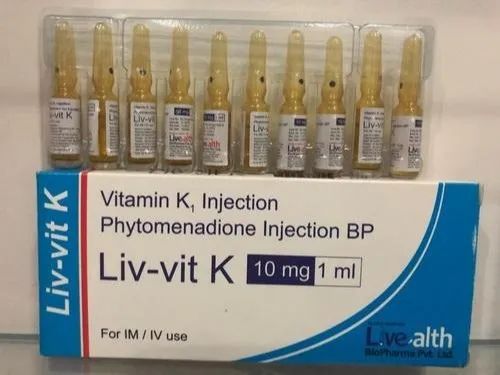Intramuscular administration of vitamin K for prevention of vitamin K deficiency bleeding (VKDB) has been a standard of care since the American Academy of Pediatrics recommended it in 1961. Despite the success of prevention of VKDB with vitamin K administration, the incidence of VKDB appears to be on the rise. This increase in incidence of VKDB is attributable to parental refusal as well as lowered efficacy of alternate methods of administration.
What is Vit K?
Vitamin K is an essential nutrient that plays a vital role in blood clotting and bone metabolism. There are two natural forms of vitamin K, K1 (phylloquinone) and K2 (menaquinone), which are found in leafy greens and animal products, respectively. However, the vitamin K shot given to infants is a synthetic form of vitamin K, known as phytonadione.
The vitamin K shot is typically given to newborns within minutes of birth to prevent a rare bleeding disorder called vitamin K deficiency bleeding (VKDB). VKDB occurs when an infant has low levels of vitamin K, which can lead to bleeding in the brain or other organs. While VKDB is rare, it can be life-threatening, which is why most states in the US mandate the administration of the vitamin K shot.
Manmade and possibly dangerous
However, the synthetic form of vitamin K used in the shot has raised concerns among some healthcare practitioners and parents. The shot contains benzyl alcohol and Polysorbate 80, which are known to target the liver and open up the blood-brain barrier. This can lead to jaundice and expose the central nervous system to viruses, bacteria, and toxins. In addition, the amount of synthetic vitamin K in the shot is over 100 times the infant’s recommended daily intake, which has raised concerns about potential harm.
Studies have linked high doses of vitamin K with childhood cancers and leukemia. While the exact metabolic fate of vitamin K is still unknown, it is a fat-soluble vitamin that has the potential to accumulate in body tissues. This can be particularly concerning for newborns, as their liver does not begin to function until several days after birth. As a result, infants have limited or no ability to detoxify the large dose of synthetic vitamin K and other ingredients in the shot.
Moreover, the shot contains two ingredients that are known to be neurotoxic: Polysorbate 80 and propylene glycol. Polysorbate 80 is a surfactant that is commonly used in pharmaceuticals and cosmetics. It has been shown to cause reproductive problems and tumors in animal studies. Propylene glycol is a synthetic substance that is used as a solvent, preservative, and sweetener. It has been linked to neurological symptoms such as seizures, dizziness, and confusion.
The manufacturer’s insert included with the vitamin K shot warns of severe reactions, including fatalities, that have occurred during and immediately after intravenous injection of phytonadione, even when precautions have been taken to dilute the vitamin and avoid rapid infusion. This warning is not an exaggeration of the risks associated with the shot.
It is important to weigh the benefits of the shot against the potential risks and to consider alternative forms of vitamin K supplementation, such as oral drops or food sources, for infants who are not at high risk of VKDB. As with any medical decision, parents should discuss the risks and benefits of the vitamin K shot with their healthcare provider and make an informed decision based on their individual circumstances.
